|
SNAP Library 2.2, Developer Reference
2014-03-11 19:15:55
SNAP, a general purpose, high performance system for analysis and manipulation of large networks
|
|
SNAP Library 2.2, Developer Reference
2014-03-11 19:15:55
SNAP, a general purpose, high performance system for analysis and manipulation of large networks
|
#include <ff.h>
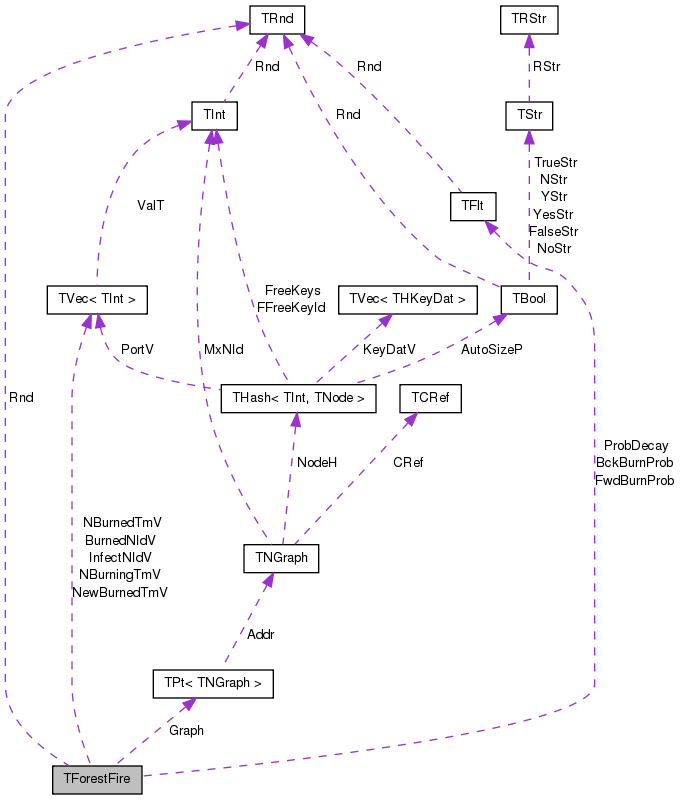
Public Member Functions | |
| TForestFire () | |
| TForestFire (const PNGraph &GraphPt, const double &ForwBurnProb, const double &BackBurnProb, const double &DecayProb=1.0, const int &RndSeed=1) | |
| void | SetGraph (const PNGraph &GraphPt) |
| PNGraph | GetGraph () const |
| void | SetBurnProb (const double &ForwBurnProb, const double &BackBurnProb) |
| void | SetProbDecay (const double &DecayProb) |
| void | Infect (const int &NodeId) |
| void | Infect (const TIntV &InfectedNIdV) |
| void | InfectAll () |
| void | InfectRnd (const int &NInfect) |
| void | BurnExpFire () |
| void | BurnGeoFire () |
| int | GetFireTm () const |
| int | GetBurned () const |
| int | GetBurnedNId (const int &NIdN) const |
| const TIntV & | GetBurnedNIdV () const |
| void | GetBurnedNIdV (TIntV &NIdV) const |
| void | PlotFire (const TStr &FNmPref, const TStr &Desc, const bool &PlotAllBurned=false) |
Static Public Member Functions | |
| static PNGraph | GenGraph (const int &Nodes, const double &FwdProb, const double &BckProb) |
Private Member Functions | |
| UndefCopyAssign (TForestFire) | |
Private Attributes | |
| TRnd | Rnd |
| PNGraph | Graph |
| TFlt | FwdBurnProb |
| TFlt | BckBurnProb |
| TFlt | ProbDecay |
| TIntV | InfectNIdV |
| TIntV | BurnedNIdV |
| TIntV | NBurnedTmV |
| TIntV | NBurningTmV |
| TIntV | NewBurnedTmV |
Simulates a single Forest Fire on a directed graph starting for a given starting node. For more details is "Graph Evolution: Densification and Shrinking Diameters" by J. Leskovec, J. Kleinberg, C. Faloutsos. ACM Transactions on Knowledge Discovery from Data (TKDD), 1(1), 2007.
| TForestFire::TForestFire | ( | ) | [inline] |
Definition at line 18 of file ff.h.
: Rnd(1), Graph(), FwdBurnProb(0.0), BckBurnProb(0.0), ProbDecay(1.0) { }
| TForestFire::TForestFire | ( | const PNGraph & | GraphPt, |
| const double & | ForwBurnProb, | ||
| const double & | BackBurnProb, | ||
| const double & | DecayProb = 1.0, |
||
| const int & | RndSeed = 1 |
||
| ) | [inline] |
Definition at line 19 of file ff.h.
:
Rnd(RndSeed), Graph(GraphPt), FwdBurnProb(ForwBurnProb), BckBurnProb(BackBurnProb), ProbDecay(DecayProb) { }
| void TForestFire::BurnExpFire | ( | ) |
Definition at line 21 of file ff.cpp.
References TVec< TVal, TSizeTy >::Add(), THash< TKey, TDat, THashFunc >::AddDat(), BckBurnProb, BurnedNIdV, TVec< TVal, TSizeTy >::Clr(), TVec< TVal, TSizeTy >::Empty(), FwdBurnProb, TVec< TVal, TSizeTy >::Gen(), TNGraph::TNodeI::GetInDeg(), TNGraph::TNodeI::GetInNId(), THash< TKey, TDat, THashFunc >::GetKey(), TNGraph::GetNI(), TNGraph::TNodeI::GetOutDeg(), TNGraph::TNodeI::GetOutNId(), TRnd::GetUniDev(), Graph, InfectNIdV, THash< TKey, TDat, THashFunc >::IsKey(), THash< TKey, TDat, THashFunc >::Len(), TVec< TVal, TSizeTy >::Len(), NBurnedTmV, NBurningTmV, NewBurnedTmV, ProbDecay, Rnd, and TVec< TVal, TSizeTy >::Swap().
Referenced by TFfGGen::AddNodes().
{
const double OldFwdBurnProb = FwdBurnProb;
const double OldBckBurnProb = BckBurnProb;
const int NInfect = InfectNIdV.Len();
const TNGraph& G = *Graph;
TIntH BurnedNIdH; // burned nodes
TIntV BurningNIdV = InfectNIdV; // currently burning nodes
TIntV NewBurnedNIdV; // nodes newly burned in current step
bool HasAliveNbrs; // has unburned neighbors
int NBurned = NInfect, NDiedFire=0;
for (int i = 0; i < InfectNIdV.Len(); i++) {
BurnedNIdH.AddDat(InfectNIdV[i]); }
NBurnedTmV.Clr(false); NBurningTmV.Clr(false); NewBurnedTmV.Clr(false);
for (int time = 0; ; time++) {
NewBurnedNIdV.Clr(false);
// for each burning node
for (int node = 0; node < BurningNIdV.Len(); node++) {
const int& BurningNId = BurningNIdV[node];
const TNGraph::TNodeI Node = G.GetNI(BurningNId);
HasAliveNbrs = false;
NDiedFire = 0;
// burn forward links (out-links)
for (int e = 0; e < Node.GetOutDeg(); e++) {
const int OutNId = Node.GetOutNId(e);
if (! BurnedNIdH.IsKey(OutNId)) { // not yet burned
HasAliveNbrs = true;
if (Rnd.GetUniDev() < FwdBurnProb) {
BurnedNIdH.AddDat(OutNId); NewBurnedNIdV.Add(OutNId); NBurned++; }
}
}
// burn backward links (in-links)
if (BckBurnProb > 0.0) {
for (int e = 0; e < Node.GetInDeg(); e++) {
const int InNId = Node.GetInNId(e);
if (! BurnedNIdH.IsKey(InNId)) { // not yet burned
HasAliveNbrs = true;
if (Rnd.GetUniDev() < BckBurnProb) {
BurnedNIdH.AddDat(InNId); NewBurnedNIdV.Add(InNId); NBurned++; }
}
}
}
if (! HasAliveNbrs) { NDiedFire++; }
}
NBurnedTmV.Add(NBurned);
NBurningTmV.Add(BurningNIdV.Len() - NDiedFire);
NewBurnedTmV.Add(NewBurnedNIdV.Len());
//BurningNIdV.AddV(NewBurnedNIdV); // node is burning eternally
BurningNIdV.Swap(NewBurnedNIdV); // node is burning just 1 time step
if (BurningNIdV.Empty()) break;
FwdBurnProb = FwdBurnProb * ProbDecay;
BckBurnProb = BckBurnProb * ProbDecay;
}
BurnedNIdV.Gen(BurnedNIdH.Len(), 0);
for (int i = 0; i < BurnedNIdH.Len(); i++) {
BurnedNIdV.Add(BurnedNIdH.GetKey(i)); }
FwdBurnProb = OldFwdBurnProb;
BckBurnProb = OldBckBurnProb;
}
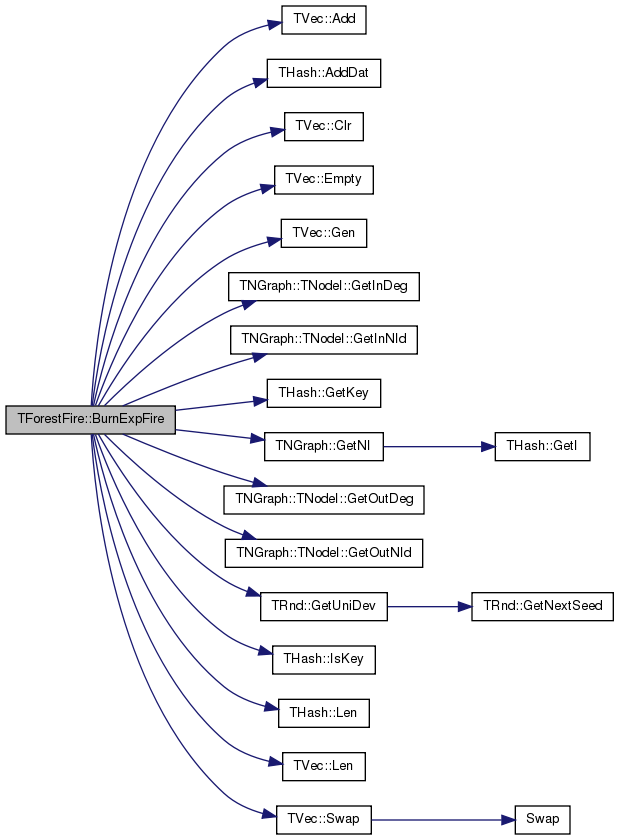

| void TForestFire::BurnGeoFire | ( | ) |
Definition at line 82 of file ff.cpp.
References TVec< TVal, TSizeTy >::Add(), THash< TKey, TDat, THashFunc >::AddDat(), BckBurnProb, BurnedNIdV, TVec< TVal, TSizeTy >::Clr(), TVec< TVal, TSizeTy >::Empty(), FwdBurnProb, TVec< TVal, TSizeTy >::Gen(), TRnd::GetGeoDev(), TNGraph::TNodeI::GetInDeg(), TNGraph::TNodeI::GetInNId(), THash< TKey, TDat, THashFunc >::GetKey(), TNGraph::GetNI(), TNGraph::TNodeI::GetOutDeg(), TNGraph::TNodeI::GetOutNId(), Graph, InfectNIdV, THash< TKey, TDat, THashFunc >::IsKey(), THash< TKey, TDat, THashFunc >::Len(), TVec< TVal, TSizeTy >::Len(), TMath::Mn(), NBurnedTmV, NBurningTmV, NewBurnedTmV, ProbDecay, Rnd, TVec< TVal, TSizeTy >::Shuffle(), and TVec< TVal, TSizeTy >::Swap().
Referenced by TFfGGen::AddNodes().
{
const double OldFwdBurnProb=FwdBurnProb;
const double OldBckBurnProb=BckBurnProb;
const int& NInfect = InfectNIdV.Len();
const TNGraph& G = *Graph;
TIntH BurnedNIdH; // burned nodes
TIntV BurningNIdV = InfectNIdV; // currently burning nodes
TIntV NewBurnedNIdV; // nodes newly burned in current step
bool HasAliveInNbrs, HasAliveOutNbrs; // has unburned neighbors
TIntV AliveNIdV; // NIds of alive neighbors
int NBurned = NInfect, time;
for (int i = 0; i < InfectNIdV.Len(); i++) {
BurnedNIdH.AddDat(InfectNIdV[i]); }
NBurnedTmV.Clr(false); NBurningTmV.Clr(false); NewBurnedTmV.Clr(false);
for (time = 0; ; time++) {
NewBurnedNIdV.Clr(false);
for (int node = 0; node < BurningNIdV.Len(); node++) {
const int& BurningNId = BurningNIdV[node];
const TNGraph::TNodeI Node = G.GetNI(BurningNId);
// find unburned links
HasAliveOutNbrs = false;
AliveNIdV.Clr(false); // unburned links
for (int e = 0; e < Node.GetOutDeg(); e++) {
const int OutNId = Node.GetOutNId(e);
if (! BurnedNIdH.IsKey(OutNId)) {
HasAliveOutNbrs = true; AliveNIdV.Add(OutNId); }
}
// number of links to burn (geometric coin). Can also burn 0 links
const int BurnNFwdLinks = Rnd.GetGeoDev(1.0-FwdBurnProb) - 1;
if (HasAliveOutNbrs && BurnNFwdLinks > 0) {
AliveNIdV.Shuffle(Rnd);
for (int i = 0; i < TMath::Mn(BurnNFwdLinks, AliveNIdV.Len()); i++) {
BurnedNIdH.AddDat(AliveNIdV[i]);
NewBurnedNIdV.Add(AliveNIdV[i]); NBurned++; }
}
// backward links
if (BckBurnProb > 0.0) {
// find unburned links
HasAliveInNbrs = false;
AliveNIdV.Clr(false);
for (int e = 0; e < Node.GetInDeg(); e++) {
const int InNId = Node.GetInNId(e);
if (! BurnedNIdH.IsKey(InNId)) {
HasAliveInNbrs = true; AliveNIdV.Add(InNId); }
}
// number of links to burn (geometric coin). Can also burn 0 links
const int BurnNBckLinks = Rnd.GetGeoDev(1.0-BckBurnProb) - 1;
if (HasAliveInNbrs && BurnNBckLinks > 0) {
AliveNIdV.Shuffle(Rnd);
for (int i = 0; i < TMath::Mn(BurnNBckLinks, AliveNIdV.Len()); i++) {
BurnedNIdH.AddDat(AliveNIdV[i]);
NewBurnedNIdV.Add(AliveNIdV[i]); NBurned++; }
}
}
}
NBurnedTmV.Add(NBurned); NBurningTmV.Add(BurningNIdV.Len()); NewBurnedTmV.Add(NewBurnedNIdV.Len());
// BurningNIdV.AddV(NewBurnedNIdV); // node is burning eternally
BurningNIdV.Swap(NewBurnedNIdV); // node is burning just 1 time step
if (BurningNIdV.Empty()) break;
FwdBurnProb = FwdBurnProb * ProbDecay;
BckBurnProb = BckBurnProb * ProbDecay;
}
BurnedNIdV.Gen(BurnedNIdH.Len(), 0);
for (int i = 0; i < BurnedNIdH.Len(); i++) {
BurnedNIdV.Add(BurnedNIdH.GetKey(i)); }
FwdBurnProb = OldFwdBurnProb;
BckBurnProb = OldBckBurnProb;
}
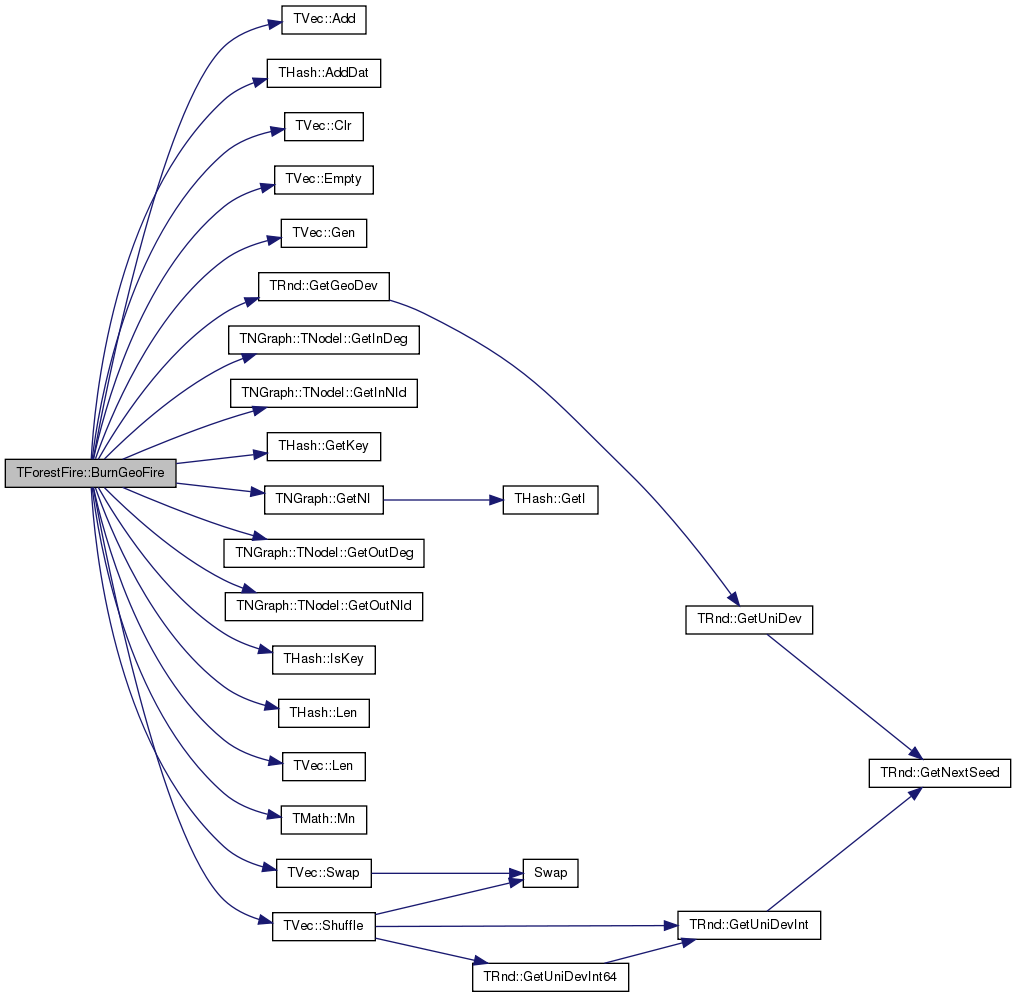

| PNGraph TForestFire::GenGraph | ( | const int & | Nodes, |
| const double & | FwdProb, | ||
| const double & | BckProb | ||
| ) | [static] |
Definition at line 250 of file ff.cpp.
References TFfGGen::GenGraph(), and TFfGGen::GetGraph().
Referenced by TSnap::GenForestFire().
{
TFfGGen Ff(false, 1, FwdProb, BckProb, 1.0, 0.0, 0.0);
Ff.GenGraph(Nodes);
return Ff.GetGraph();
}
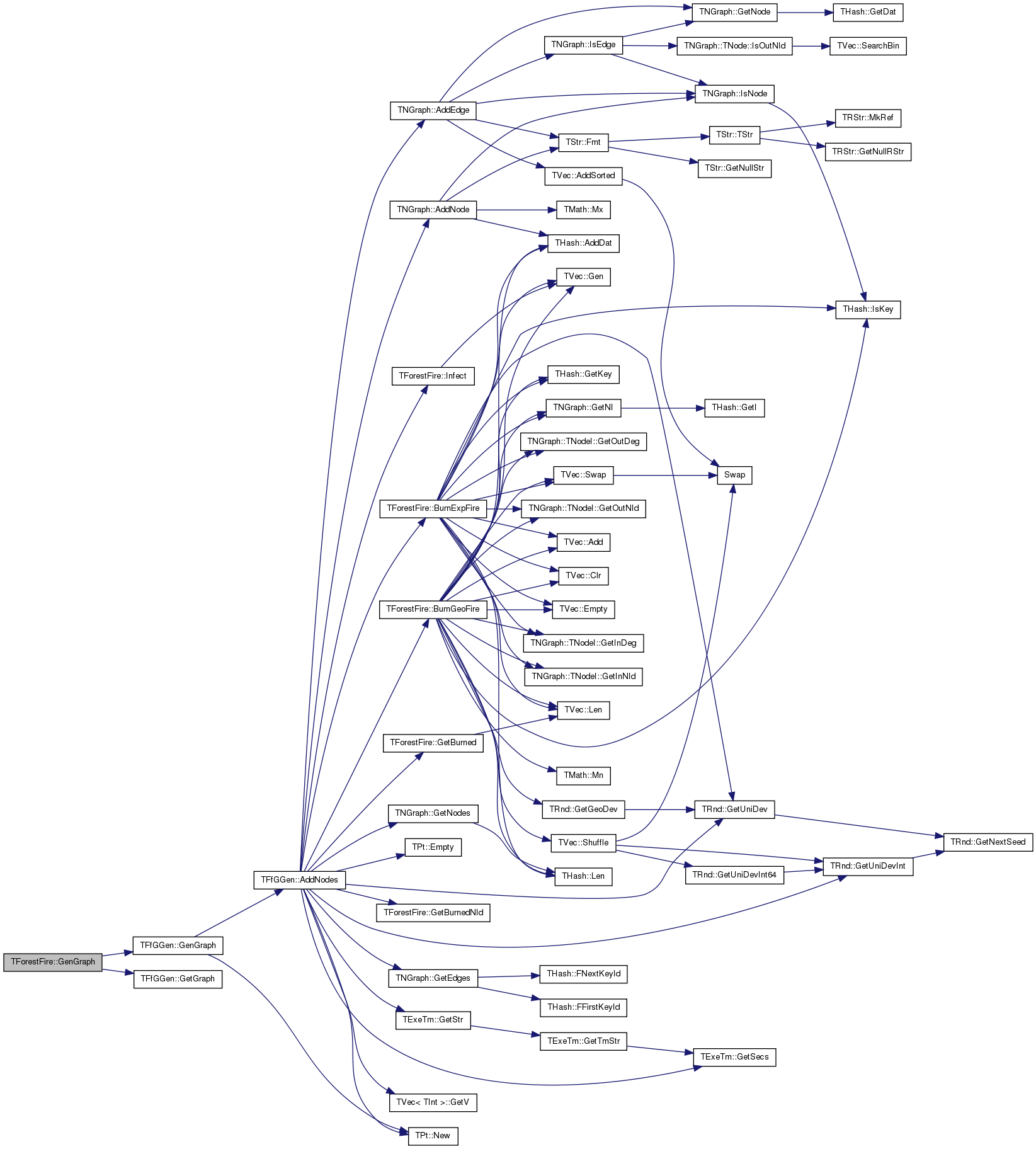

| int TForestFire::GetBurned | ( | ) | const [inline] |
Definition at line 36 of file ff.h.
References BurnedNIdV, and TVec< TVal, TSizeTy >::Len().
Referenced by TFfGGen::AddNodes().
{ return BurnedNIdV.Len(); }


| int TForestFire::GetBurnedNId | ( | const int & | NIdN | ) | const [inline] |
Definition at line 37 of file ff.h.
References BurnedNIdV.
Referenced by TFfGGen::AddNodes().
{ return BurnedNIdV[NIdN]; }

| const TIntV& TForestFire::GetBurnedNIdV | ( | ) | const [inline] |
| void TForestFire::GetBurnedNIdV | ( | TIntV & | NIdV | ) | const [inline] |
| int TForestFire::GetFireTm | ( | ) | const [inline] |
Definition at line 35 of file ff.h.
References TVec< TVal, TSizeTy >::Len(), and NBurnedTmV.
{ return NBurnedTmV.Len(); } // time of fire

| PNGraph TForestFire::GetGraph | ( | ) | const [inline] |
| void TForestFire::Infect | ( | const int & | NodeId | ) | [inline] |
Definition at line 27 of file ff.h.
References TVec< TVal, TSizeTy >::Gen(), and InfectNIdV.
Referenced by TFfGGen::AddNodes().
{ InfectNIdV.Gen(1,1); InfectNIdV[0] = NodeId; }


| void TForestFire::Infect | ( | const TIntV & | InfectedNIdV | ) | [inline] |
| void TForestFire::InfectAll | ( | ) |
Definition at line 3 of file ff.cpp.
References TVec< TVal, TSizeTy >::Add(), TNGraph::BegNI(), TNGraph::EndNI(), TVec< TVal, TSizeTy >::Gen(), TNGraph::GetNodes(), Graph, and InfectNIdV.
{
InfectNIdV.Gen(Graph->GetNodes());
for (TNGraph::TNodeI NI = Graph->BegNI(); NI < Graph->EndNI(); NI++) {
InfectNIdV.Add(NI.GetId()); }
}
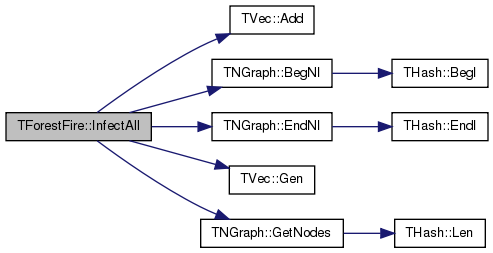
| void TForestFire::InfectRnd | ( | const int & | NInfect | ) |
Definition at line 9 of file ff.cpp.
References TVec< TVal, TSizeTy >::Add(), TNGraph::BegNI(), TNGraph::EndNI(), TVec< TVal, TSizeTy >::Gen(), TNGraph::GetNodes(), Graph, IAssert, InfectNIdV, and Rnd.
{
IAssert(NInfect < Graph->GetNodes());
TIntV NIdV(Graph->GetNodes(), 0);
for (TNGraph::TNodeI NI = Graph->BegNI(); NI < Graph->EndNI(); NI++) {
NIdV.Add(NI.GetId()); }
NIdV.Shuffle(Rnd);
InfectNIdV.Gen(NInfect, 0);
for (int i = 0; i < NInfect; i++) {
InfectNIdV.Add(NIdV[i]); }
}
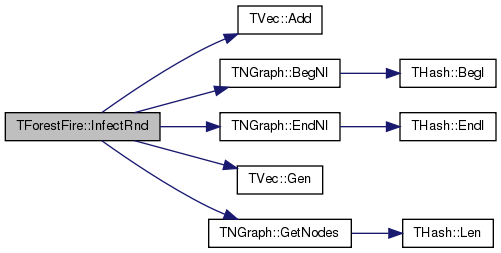
| void TForestFire::PlotFire | ( | const TStr & | FNmPref, |
| const TStr & | Desc, | ||
| const bool & | PlotAllBurned = false |
||
| ) |
Definition at line 240 of file ff.cpp.
References TGnuPlot::AddPlot(), BckBurnProb, TStr::CStr(), TStr::Fmt(), FwdBurnProb, TNGraph::GetEdges(), TNGraph::GetNodes(), TFile::GetUniqueFNm(), gpwLinesPoints, Graph, InfectNIdV, TVec< TVal, TSizeTy >::Len(), NBurnedTmV, NBurningTmV, NewBurnedTmV, TGnuPlot::SavePng(), and TGnuPlot::SetXYLabel().
{
TGnuPlot GnuPlot(FNmPref, TStr::Fmt("%s. ForestFire. G(%d, %d). Fwd:%g Bck:%g NInfect:%d",
Desc.CStr(), Graph->GetNodes(), Graph->GetEdges(), FwdBurnProb(), BckBurnProb(), InfectNIdV.Len()));
GnuPlot.SetXYLabel("TIME EPOCH", "Number of NODES");
if (PlotAllBurned) GnuPlot.AddPlot(NBurnedTmV, gpwLinesPoints, "All burned nodes till time");
GnuPlot.AddPlot(NBurningTmV, gpwLinesPoints, "Burning nodes at time");
GnuPlot.AddPlot(NewBurnedTmV, gpwLinesPoints, "Newly burned nodes at time");
GnuPlot.SavePng(TFile::GetUniqueFNm(TStr::Fmt("fireSz.%s_#.png", FNmPref.CStr())));
}
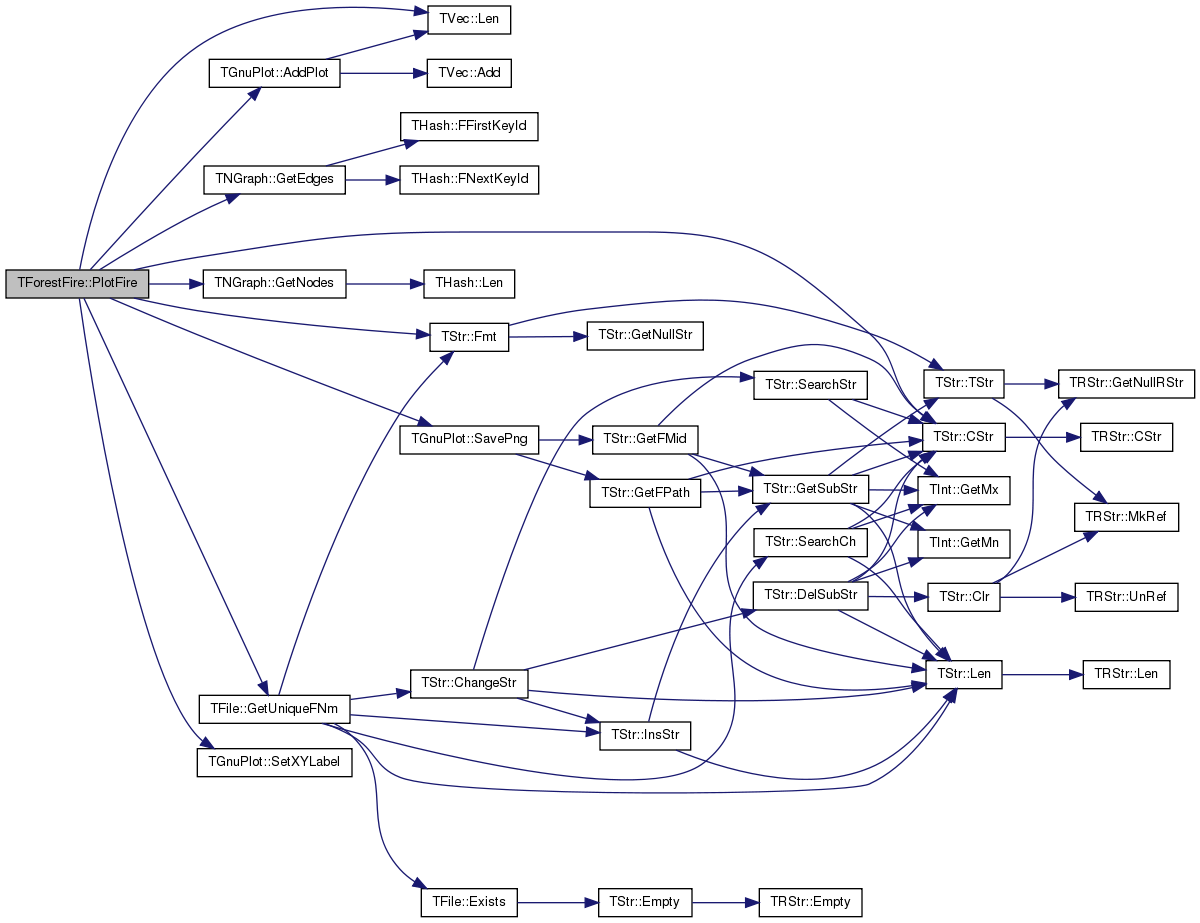
| void TForestFire::SetBurnProb | ( | const double & | ForwBurnProb, |
| const double & | BackBurnProb | ||
| ) | [inline] |
Definition at line 24 of file ff.h.
References BckBurnProb, and FwdBurnProb.
{ FwdBurnProb=ForwBurnProb; BckBurnProb=BackBurnProb; }
| void TForestFire::SetGraph | ( | const PNGraph & | GraphPt | ) | [inline] |
| void TForestFire::SetProbDecay | ( | const double & | DecayProb | ) | [inline] |
| TForestFire::UndefCopyAssign | ( | TForestFire | ) | [private] |
TFlt TForestFire::BckBurnProb [private] |
Definition at line 10 of file ff.h.
Referenced by BurnExpFire(), BurnGeoFire(), PlotFire(), and SetBurnProb().
TIntV TForestFire::BurnedNIdV [private] |
Definition at line 12 of file ff.h.
Referenced by BurnExpFire(), BurnGeoFire(), GetBurned(), GetBurnedNId(), and GetBurnedNIdV().
TFlt TForestFire::FwdBurnProb [private] |
Definition at line 10 of file ff.h.
Referenced by BurnExpFire(), BurnGeoFire(), PlotFire(), and SetBurnProb().
PNGraph TForestFire::Graph [private] |
Definition at line 9 of file ff.h.
Referenced by BurnExpFire(), BurnGeoFire(), GetGraph(), InfectAll(), InfectRnd(), PlotFire(), and SetGraph().
TIntV TForestFire::InfectNIdV [private] |
Definition at line 11 of file ff.h.
Referenced by BurnExpFire(), BurnGeoFire(), Infect(), InfectAll(), InfectRnd(), and PlotFire().
TIntV TForestFire::NBurnedTmV [private] |
Definition at line 14 of file ff.h.
Referenced by BurnExpFire(), BurnGeoFire(), GetFireTm(), and PlotFire().
TIntV TForestFire::NBurningTmV [private] |
Definition at line 14 of file ff.h.
Referenced by BurnExpFire(), BurnGeoFire(), and PlotFire().
TIntV TForestFire::NewBurnedTmV [private] |
Definition at line 14 of file ff.h.
Referenced by BurnExpFire(), BurnGeoFire(), and PlotFire().
TFlt TForestFire::ProbDecay [private] |
Definition at line 10 of file ff.h.
Referenced by BurnExpFire(), BurnGeoFire(), and SetProbDecay().
TRnd TForestFire::Rnd [private] |
Definition at line 8 of file ff.h.
Referenced by BurnExpFire(), BurnGeoFire(), and InfectRnd().